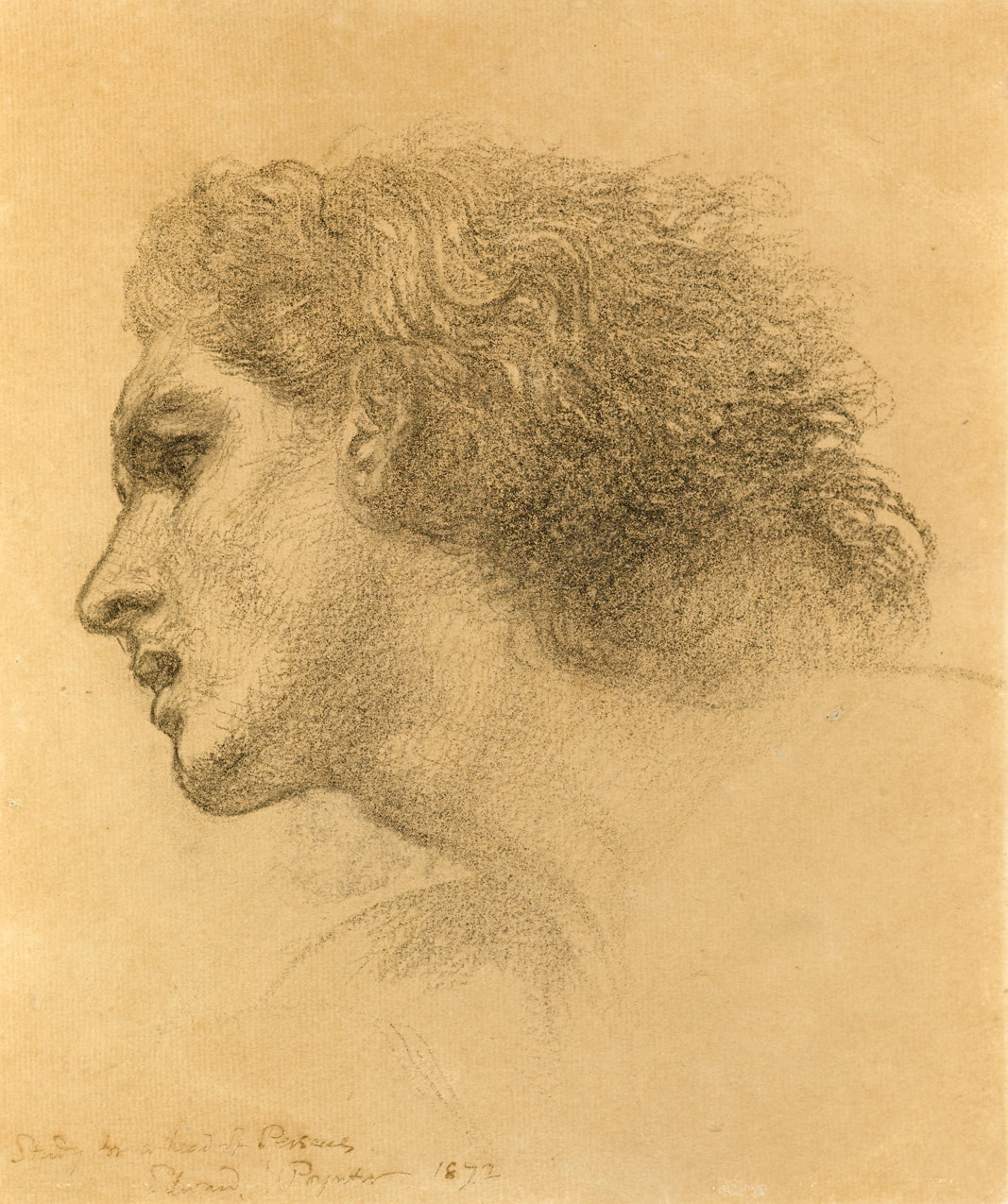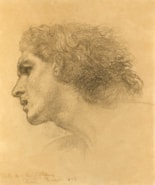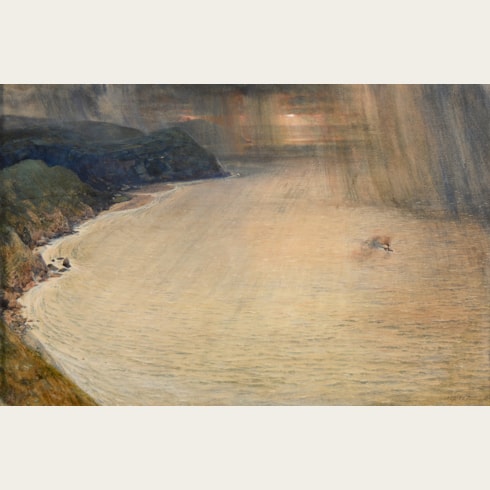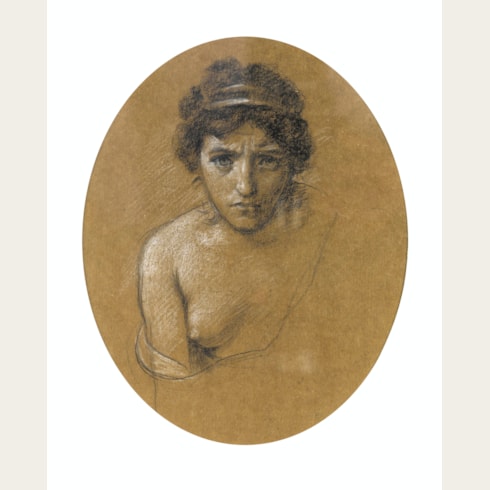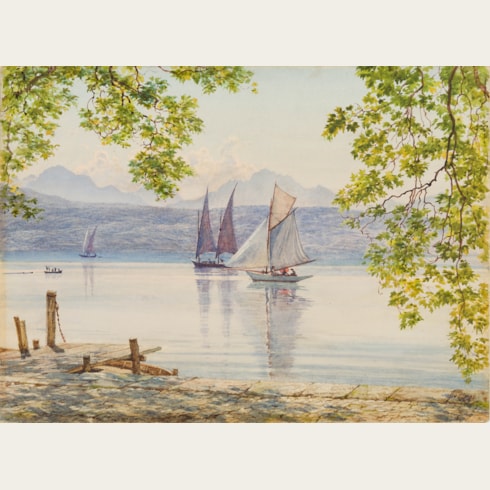Edward John POYNTER
(Paris 1836 - London 1919)
Study for the Head of Perseus
Sold
Black chalk.
Signed, inscribed and dated Study for a head of Perseus / Edward Poynter 1872 at the lower left.
264 x 225 mm. (10 3/8 x 8 7/8 in.)
Signed, inscribed and dated Study for a head of Perseus / Edward Poynter 1872 at the lower left.
264 x 225 mm. (10 3/8 x 8 7/8 in.)
This drawing is a study for the head of Perseus in the large painting of Perseus and Andromeda, commissioned from Poynter by the Earl of Wharncliffe for the billiard room at his country seat at Wortley Hall, near Sheffield in South Yorkshire. Poynter received the commission from Wharncliffe, at the recommendation of Sir John Everett Millais, in 1871 and completed the painting the following year. This enormous canvas, measuring five feet by thirteen feet, was exhibited at the Royal Academy in 1872, and elicited much praise from critics.
The Perseus and Andromeda was to be the first part of an impressive decorative scheme. Poynter painted a further three large paintings for the billiard room, each of which were also exhibited at the Royal Academy before being sent to Wortley. These were The Fight between More of More Hall and the Dragon of Wantley, painted in 1873, Atalanta's Race, painted in 1876, and Nausicaa and her Maidens Playing at Ball, completed in 1879. Poynter also painted a large full-length portrait of the Earl of Wharncliffe for the room, which was installed in 1881. Sadly, all of the paintings for the billiard room at Wortley Hall were destroyed during the Second World War, and their appearance is today known only from old photographs and from the handful of preparatory studies that survive.
An oil sketch for the Perseus and Andromeda was on the London art market in 1971, while a large and highly finished preparatory drawing for the composition, executed in charcoal and coloured chalks, is at Rugby School in Warwickshire. A highly finished drawing in black chalk for the figure of Andromeda, signed and dated 1872, was sold at auction in 2001 and is today in a private collection in Australia.
The present sheet was exhibited at sixth annual Exhibition of Works of Art in Black and White, held in 1878 at the Dudley Gallery in the Egyptian Hall in Piccadilly, London.
The Perseus and Andromeda was to be the first part of an impressive decorative scheme. Poynter painted a further three large paintings for the billiard room, each of which were also exhibited at the Royal Academy before being sent to Wortley. These were The Fight between More of More Hall and the Dragon of Wantley, painted in 1873, Atalanta's Race, painted in 1876, and Nausicaa and her Maidens Playing at Ball, completed in 1879. Poynter also painted a large full-length portrait of the Earl of Wharncliffe for the room, which was installed in 1881. Sadly, all of the paintings for the billiard room at Wortley Hall were destroyed during the Second World War, and their appearance is today known only from old photographs and from the handful of preparatory studies that survive.
An oil sketch for the Perseus and Andromeda was on the London art market in 1971, while a large and highly finished preparatory drawing for the composition, executed in charcoal and coloured chalks, is at Rugby School in Warwickshire. A highly finished drawing in black chalk for the figure of Andromeda, signed and dated 1872, was sold at auction in 2001 and is today in a private collection in Australia.
The present sheet was exhibited at sixth annual Exhibition of Works of Art in Black and White, held in 1878 at the Dudley Gallery in the Egyptian Hall in Piccadilly, London.
One of the leading artistic figures of Victorian England, Edward Poynter made his reputation as a painter of historical subjects, often set in ancient times, in which precise archeological detail, interesting narrative themes and a polished technique were combined with great effect. His first success came with the painting Israel in Egypt, exhibited at the Royal Academy in 1867, and his reputation continued to rise throughout his career, enhanced by such popular paintings as A Visit to Aesculapius, painted in 1880. His grandest production was the monumental The Visit of the Queen of Sheba to King Solomon, painted between 1883 and 1890 and today in the Art Gallery of New South Wales in Sydney, Australia. Among the public commissions he received were for the decoration of the interior of the Palace of Westminster and the Royal Albert Hall.
Poynter also worked in watercolour and fresco, and made designs for stained glass, mosaic and ceramics. Apart from being the first Slade Professor of Art at University College in London, Poynter was appointed Director of the National Gallery in 1894 (the last artist to hold the position) and, from 1896, served concurrently as President of the Royal Academy.
A versatile and gifted draughtsman and a firm advocate of life drawing, Poynter made numerous figure studies for each of his paintings. His drawings were greatly admired in his lifetime. As one recent scholar has noted, ‘By the late 1860’s Poynter’s graphic work was renowned for its excellence, and by the 1880s he was hailed by his contemporaries as the finest British figure draughtsman of his time.’ One contemporary writer, in a book devoted solely to the artist’s drawings, noted of Poynter’s preparatory studies for his paintings that ‘In the bold vigour of his generalizations, in the minute and searching attention to details, and in the broad and masterly use of the material, be it charcoal, chalk, or pencil, we perceive how conscientiously he has laid to heart the example long since set by Michel Angelo.’
Provenance
With Peter Nahum, London, in 1989.
Literature
Hilary Morgan, Burne-Jones, The Pre-Raphaelites and Their Century, exhibition catalogue, London, 1989, Vol.I, p.109, no.110, Vol.II, pl.79.
Exhibition
London, Egyptian Hall, The Dudley Gallery, Exhibition of Works of Art in Black and White, 1878, no.586 (priced at £15.15); London, Peter Nahum, Burne-Jones, The Pre-Raphaelites and Their Century, 1989, no.110.

